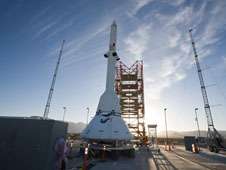The launch abort vehicle stands ready for launch at the Orion Abort Flight Test Launch Complex 32E. Image Credit: U.S. Army White Sands Test Facility
(PhysOrg.com) -- NASA’s latest flight test, called Pad Abort 1 (PA-1), is scheduled for launch on Thursday, May 6, at the Orion Abort Flight Test Launch Complex 32E at the U.S. Army’s White Sands Missile Range (WSMR) near Las Cruces, N.M. The launch window extends from 8 a.m. to 11 a.m. CDT, with liftoff targeted for the beginning of the window.
"PA-1 is part of NASA's ongoing mission to develop safer space vehicles for all human spaceflight applications. Information gathered through PA-1 testing will be valuable in design and development of those future systems," said Stephen Gaddis, deputy manager of the launch abort system (LAS) at Marshall Space Flight Center in Huntsville, Ala. Testing the LAS performance and LAS to crew module interface are the principal objectives of PA-1. "The integrated LAS system performance cannot be adequately tested except in abort flight test conditions such as PA-1," Gaddis added.
The Launch Abort System contains three newly designed solid propulsion systems, each of which performs a unique aspect of the abort mission.
The biggest of the three is the abort motor at the bottom of the Launch Abort System stack. "It’s fast and furious, reaching about 500,000 pounds of thrust force in less than a tenth of a second, and accelerating the Launch Abort Vehicle from zero to nearly 600 mph in about four seconds," said Dr. Jeffrey Sheehy, deputy chief engineer for the launch abort system at Marshall. It’s designed to extract the crew module from the launch vehicle as quickly as possible so it can be flown to safety in the event of an anomaly during the trip to space.
The jettison motor, in the middle of the stack, is the smallest of the three propulsion systems. It will be used to remove the Launch Abort System tower from the crew module on every mission. For nominal flights with no abort, the LAS tower is jettisoned at about 55 miles altitude, near the edge of space. In the event of an abort, the tower is jettisoned after the launch abort vehicle has been reoriented; removing the tower allows the crew module to deploy its parachute systems.
The attitude control motor, near the top of the stack, provides stability control and reorientation propulsion for the launch abort vehicle. "It’s a huge advancement in controllable solid rocket technology, representing a 25-fold scale-up over previously flown systems of this type," said Sheehy.
Gaddis praised the NASA team for working long hours to oversee the completion of all tests leading to the Pad Abort 1 flight, performing Hardware Acceptance Reviews for all the flight subsystems, and for verifying the closure rationale for more than 1300 project requirements.
"The launch of Pad Abort 1 on May 6 will be a history-making event since this is the first new crew escape system that has been developed in over 40 years," said Gaddis. "There is no other system in the world like it and I feel privileged to have been a part of it."
Provided by JPL/NASA






















